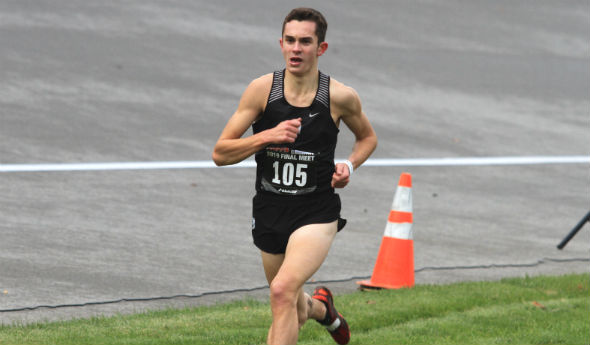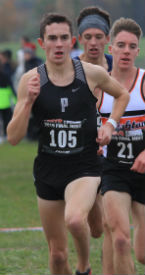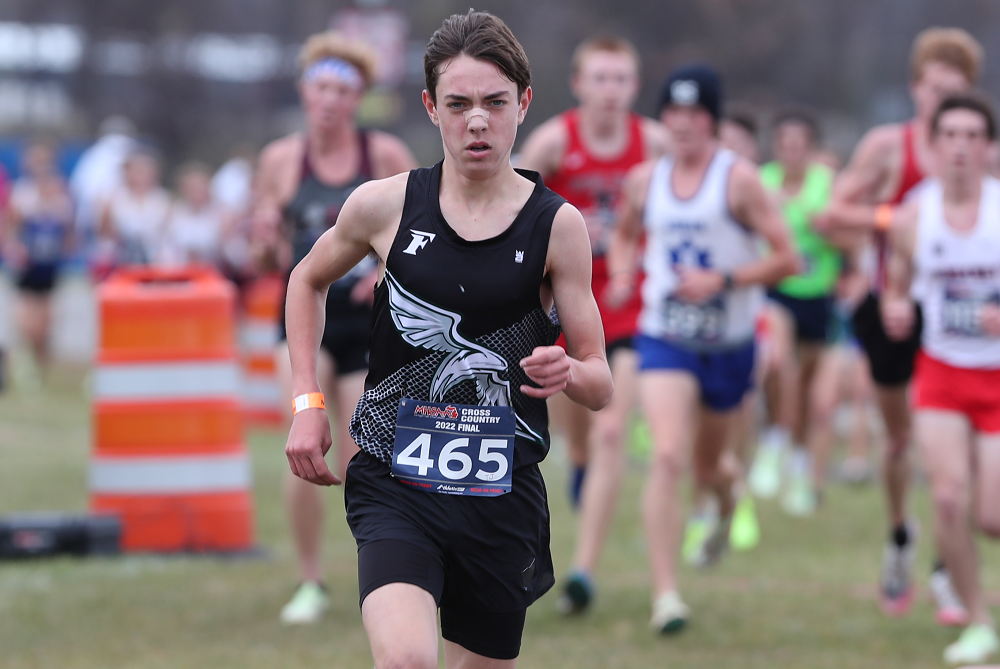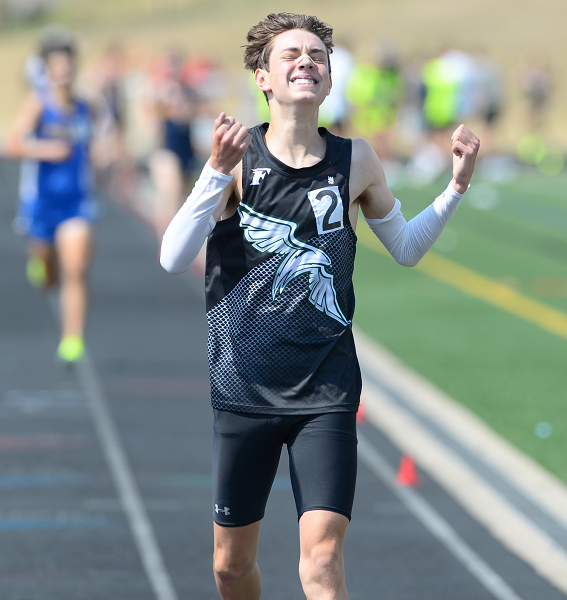
Performance: Plymouth's Carter Solomon
November 7, 2019
 Carter Solomon
Carter Solomon
Plymouth senior – Cross Country
Plymouth’s top runner the last three years capped his high school cross country career as the state’s best – and one of its fastest champions all-time. Solomon won the Lower Peninsula Division 1 championship Saturday at Michigan International Speedway in 15:01.2, the sixth-fastest 5K Finals time in state history, earning him the MHSAA “Performance of the Week.”
Solomon had finished 18th (and second among Plymouth runners) at the Finals as a freshman, then fifth as a sophomore and second as a junior before crossing the line first and five seconds ahead of the field in his last high school race at MIS. The win capped an unbeaten season for Solomon, and that’s no small achievement – not only is LP Division 1 generally the fastest annually in the state, but four more of the top seven runners at this year’s meet were from Solomon’s Kensington Lakes Activities Association. He also ran at invitationals against a number of other contenders from other divisions, including twice against Dearborn Divine Child’s Anthony and Michael Hancock, who finished second and third, respectively, in LP Division 2. Solomon’s season and personal-best 14:42.7 actually came at the Regional at Ann Arbor Huron, where he cleared the field by more than 31 seconds.
As a team, Plymouth finished 12th at the Finals after earning the championship in 2018 and finishing runner-up in 2017 – again, both times with Solomon in the lead. He also will help pace the track & field team one more season in the spring after finishing fourth in the 1,600 and ninth in the 3,200 at last year’s LPD1 Finals. Solomon will continue his running and academic careers next year at University of Notre Dame; he’s carrying a 4.0 grade-point average this school year and will study either mechanical or aerospace engineering.
Coach Jonathan Mikosz said: “Carter is one of those runners that you dream about being able to coach. Not many other coaches have ever had the opportunity to coach a better runner in this state. When you have a guy on your team of that caliber, I think it helps bring out the best in other guys as well. He was a huge part of our teams that were state champions and state runners-up back-to-back years. … In this day and age when people are hiring private coaches and looking at the internet for advice, it has been great that someone of his abilities has bought in 100 percent into our system and our coaching plan. He has bought in since day one and always trusted us as coaches. That's rare in this day and age, but him being so coachable has also (contributed) to his success. I couldn't be prouder of what he has been able to accomplish. … He has worked hard and has stayed humble with his success. That's one of the things I am most proud of. We have both learned a lot from each other. He will definitely be missed next season.”
Performance Point: “This weekend was awesome. I keep thinking about that race and everyone at the end and how it truly was an experience I will never forget. (It was) the last piece of the puzzle for my high school career. My season’s not quite over yet; I want to race at Foot Locker. The team title was awesome – I was happy for the team – but coming in second (individually last year) was a bummer and I knew I wanted to come back next year and win it and check off the team title and individual title boxes on my resume. Getting that done this year was truly awesome."

Providing the push: “I talk to the guys at other schools too; we talk about our races and what not. Having them there definitely is motivation, and I use that to push me while I am training. I have teammates too; Patrick Byrnes, he is a good training partner. I’m thankful for my competition.”
Ready to rock: “Before I even go to the meet, I will run around my neighborhood for a shake-out run, but that’s pretty common. I listen to music in my headphones. I have a playlist mixed with Foo Fighters, Korn, a little Metallica, your heavier metal classic rock kind of music.”
No place like home: “(My favorite course) is our home course, Cass Benton Park. I like it because everyone else hates it, People come in, ‘Oh, we have to race there …’ Well, you’re lucky you get to race it. It’s a tough course – it’s hilly, it’s long, it’s hard to mentally get through. But I’ve raced it so many times throughout my high school career, and even in middle school I raced it a couple of time. I’ve just grown to love it.”
Running is for me: “I think the feeling I get after accomplishing my goals is what I work for. Practice six days a week, training a long time and coming up short is demoralizing. But when you reach the goals you set for yourself, and you do the things you didn’t know were possible a couple of months before, I think that is really why I am addicted to it.”
Engineer it: “When I was young, I was curious about how things worked and taking stuff apart. My dad introduced engineering to me, and I joined the engineering program at our school my freshman year. We did a lot of cool stuff in the engineering field, trying to get an introduction to it, and I really like it.”
– Paige Winne, Second Half
Past honorees
Nov. 1: Jameson Goorman, Muskegon Western Michigan Christian soccer - Report
Oct. 24: Austin Plotkin, Brimley cross country - Report
Oct. 17: Jack Spamer, Brighton cross country - Report
Oct. 10: Kaylee Maat, Hudsonville volleyball - Report
Oct. 3: Emily Paupore, Negaunee cross country - Report
Sept. 26: Josh Mason, South Lyon soccer - Report
Sept. 19: Ariel Chang, Utica Eisenhower golf - Report
Sept. 12: Jordyn Shipps, DeWitt swimming - Report
PHOTOS: (Top) Plymouth's Carter Solomon races down the home stretch during Saturday's Division 1 Final at Michigan International Speedway. (Middle) Solomon leads a pack, including Brighton's Jack Spamer, earlier in the race. (Photos by Matt Yacoub/RunMichigan.com.)

Freeland's Hansen Not Focused on Joining All-Time Greats - But On His Way
By
Paul Costanzo
Special for MHSAA.com
September 29, 2023
The goal written on Matt Kaczor’s Post-It Note was sub-15 minutes, 15 seconds. That’s what the Freeland cross country coach was hoping for from star runner TJ Hansen during his junior season.
 Kaczor tore it up after seeing Hansen run a single race this fall.
Kaczor tore it up after seeing Hansen run a single race this fall.
“Knowing what he did over the summer and where he was at, seeing what his 1,600 (meter) and his mile got down to, I had a feeling he could get under 15:30 quickly,” Kaczor said. “After the first race, I looked at my assistant and was like, ‘I’ve gotta rip up that Post-It Note. I don’t think our goal is on the level of where he’s at right now.’ At first, it was break 15:15. Once I saw him race at the Under the Lights (on Aug. 18 at St. Johns), I was like, ‘Yeah, he’s going sub 15.’”
Hansen ran 15:39.6 in that first race, and on Sept. 7, in Shepherd, he ran 15:13.9 to meet the goal written on the now-shredded Post-It Note.
This past Saturday, he ran 15:03.7 at the Cadillac Veterans Serving Veterans Invitational. It’s the fastest time recorded in Michigan this year, and a signal that Kaczor might be filling out a new Post-It Note before the season is out.
“The sub-15 barrier, that’s been something on my mind for a while,” Hansen said. “Now that I’m edging closer and closer to that, it’s been exciting. With how heavy my training has been, I wouldn’t expect (to have run this fast this early). Being able to run the times I am really paints the picture for what’s ahead.”
Hansen came into the season already regarded as one of the elite distance runners in the state. He won the 3,200 meters at the MHSAA Lower Peninsula Division 2 Track & Field Finals this past spring. He’s also finished all-state (12th and fifth, respectively) the past two seasons at the LPD2 Cross Country Finals.
His current trajectory, however, would put his name near some of the state’s all-time greats. But that’s not something Hansen is focusing on.
“I really don’t like to compare myself to others,” he said. “I don’t focus on that. I try to be the best TJ Hansen that I can be. The best version of myself.”
Focusing on himself is almost necessary for Hansen, as he’s spending a lot of time during his races running by himself.
At each of the big events Freeland has run in this season, Hansen has finished at least 20 seconds ahead of his nearest competitor. That includes all divisions of the Duane Raffin Festival of Races in Holly.
In Cadillac, where Hansen ran his current best time, he was a full minute ahead of the rest of the field.
 “He’s just a special athlete,” Kaczor said. “I can’t see Freeland having someone like this in a while. He’s a generational talent. What’s crazy is, I had the school record when he was a freshman. He and Braden (Honsinger) broke it last year. But TJ has now dropped that school record (set in 1998) by almost a minute.”
“He’s just a special athlete,” Kaczor said. “I can’t see Freeland having someone like this in a while. He’s a generational talent. What’s crazy is, I had the school record when he was a freshman. He and Braden (Honsinger) broke it last year. But TJ has now dropped that school record (set in 1998) by almost a minute.”
Hansen’s achievements have already put him on a path to run at the next level, which is something of a family tradition.
His older sisters Peyton and Kiera are track & field athletes at Wayne State and Eastern Michigan, respectively. Their parents, Tim and Pam, were track & field stars at Central Michigan.
TJ has drawn the attention of coaches around the country, including from Michigan, Michigan State, Wisconsin, Tennessee and Colorado.
Having family members who know the process is a help for Hansen, and he said they’ve all been good about allowing him to choose his own path, whatever that may be.
“He’s from a good family that knows how to work and knows how to get things done,” Kaczor said. “He knows that if he puts in the work, he’s going to be at a good spot.”
While Hansen admits it can be a bit overwhelming, he’s using it as motivation to run faster and continue to put his name out there.
Also serving as motivation is 2022 Division 2 champion Connell Alford of Chelsea. Alford is among the elite group of runners in Michigan who have broken the 15-minute mark, doing it twice a year ago.
He currently has the state’s second-best time behind Hansen’s this year, running 15:09.1 at the MSU Invitational on Sept. 15.
“Whenever I see him drop a time, my main goal is to run faster,” Hansen said. “Whenever I see him run a good time, that motivates me to work hard.”
The two won’t see each other until the MHSAA Finals on Nov. 4 at Michigan International Speedway. It’s an opportunity Hansen is excited for, as it’s a chance to race and be pushed toward the lofty goals he’s set for himself. Kaczor is excited about it, too, even if it might mean having to replenish his supply of Post-Its.
“We don’t talk about winning the state title; we talk about making sure that we have great races on those days,” Kaczor said. “We can’t control how somebody else runs. It’s a matter of can we, if the weather is right and the course is in good condition, can we be one of the few guys that has run in the 14s on that course? That’s the goal. Put yourself in some great categories with those upper echelons and the greats of all-time.”
 Paul Costanzo served as a sportswriter at The Port Huron Times Herald from 2006-15, including three years as lead sportswriter, and prior to that as sports editor at the Hillsdale Daily News from 2005-06. He can be reached at [email protected] with story ideas for Genesee, Lapeer, St. Clair, Sanilac, Huron, Tuscola, Saginaw, Bay, Arenac, Midland and Gladwin counties.
Paul Costanzo served as a sportswriter at The Port Huron Times Herald from 2006-15, including three years as lead sportswriter, and prior to that as sports editor at the Hillsdale Daily News from 2005-06. He can be reached at [email protected] with story ideas for Genesee, Lapeer, St. Clair, Sanilac, Huron, Tuscola, Saginaw, Bay, Arenac, Midland and Gladwin counties.
PHOTOS (Top) Freeland's TJ Hansen leads a pack during last season's LPD2 Final at Michigan International Speedway. (Middle) Hansen enjoys a moment of exhilaration after winning the 3,200 this spring at the LPD2 Finals at Ada Forest Hills Eastern. (Top photo by Carter Sherline/Run Michigan; middle photo by Dave McCauley/Run Michigan.)

